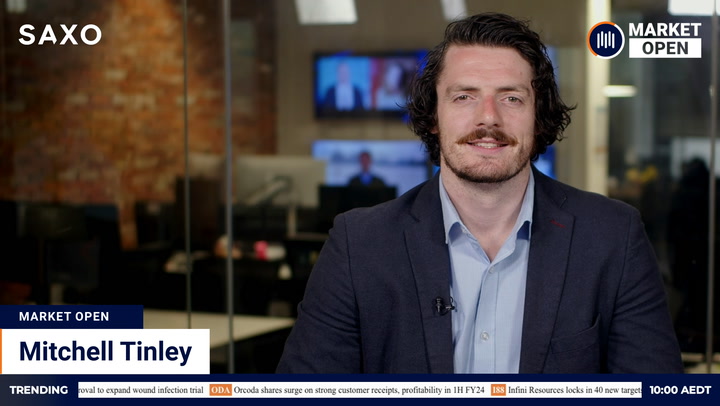Stock investors face heavy selling when the market reopens this morning after fears of a wider Covid-19 lockdown in China triggered sharp falls in Asian shares and commodity prices.
ASX futures fell for a second day despite a partial rebound on Wall Street. The ASX 200 looked set to open almost 150 points or around 3 per cent lower after a surge in turbulence across the long weekend.
Australian futures plunged 122 points or 2.77 per cent on Friday as Wall Street swooned. They added to those losses this morning, falling another 25 points or 0.34 per cent.
Iron ore plunged almost 10 per cent as China battled a widening Covid outbreak. US oil fell back under US$100 a barrel. Copper hit a three-month low. Gold ended at its weakest since February.
Wall Street
The Dow Jones Industrial Average suffered its worst loss since 2020 on Friday before mounting a partial recovery overnight as fears of a global slowdown pulled down interest rates.
The Dow closed 238 points or 0.7 per cent ahead this morning after being down almost 500 points intraday. The S&P 500 bounced 24 points or 0.57 per cent. The Nasdaq Composite rose 166 points or 1.29 per cent.
Dip-buyers snapped up beaten-up Big Tech stocks after Twitter accepted a private takeover offer from Elon Musk. Microsoft and Google parent company Alphabet rallied ahead of tonight’s earnings reports. Meta Platforms, Apple and Amazon also overcame early losses. Twitter bounced 5.66 per cent.
“We got very oversold across almost all sectors. The S&P 500 got to a place where it was able to hold and that tends to start some momentum in the other direction,” Art Hogan, chief market strategist at National Securities Corporation, said.
Earlier, the main indices opened deep in the red following heavy falls in Europe and Asia. China’s Shanghai Composite dived 5.13 per cent yesterday amid fears of a Beijing lockdown as infections spread and the government pursues a zero-Covid policy.
Authorities began testing millions of people in Beijing yesterday in a bid to avert a citywide lockdown. The development triggered panic buying in supermarkets.
The Shenzen Component Index shed 6.08 per cent. Hong Kong’s Hang Seng fell 3.73 per cent. The pan-European Stoxx 600 lost 1.81 per cent as investors prepared for supply-chain issues to worsen under a broader Chinese lockdown.
The overnight gains in the US reversed some of Friday’s heavy selling. The Nasdaq fell back into bear market territory on Friday and the S&P 500 again into a technical correction as rates rose and earnings disappointed.
The Dow shed 981 points or 2.82 per cent during its heaviest single-session decline since October 2020. The S&P 500 gave up 2.77 per cent and the Nasdaq 2.55 per cent.
Australian outlook
Seatbelts on. The S&P/ASX 200 looks set to erase a month’s gains as trade resumes here following two wild sessions on overseas markets across the Anzac Day long weekend. How the session plays out will likely depend on whether Chinese stocks steady at two-year lows or fall further.
The dollar has been hammered mercilessly across the holiday. The Aussie, which was trading above 74.5 US cents on Friday, declined 0.72 per cent to 71.8 US cents this morning. That is a huge move for a major currency, reflecting dire expectations for Australian exports prices if Beijing goes into lockdown.
Wall Street rebounded overnight, but not by nearly enough to shield the local market from turmoil in Asia and on commodity markets. Miners and energy producers look likely to bear the brunt of the selling here following sharp declines in iron ore, crude and metals (more below).
The US energy sector slid 3.34 per cent overnight even as much of the wider market recovered. The materials sector lost 0.29 per cent. Heavyweights BHP and Rio Tinto slumped in US and UK trade.
The night’s best US performers were the three sectors associated with Big Tech: communication services +1.53 per cent, technology +1.44 per cent and consumer discretionary +0.78 per cent. Health gained 0.66 per cent, consumer staples 0.41 per cent and financials 0.16 per cent.
The last week of the domestic quarterly reporting season brings a flood of reports. Many of the big guns have reported, but the market has still to hear from Woodside Petroleum, Beach Petroleum, South32 (today); Fortescue Metals, Newcrest, IGO, St Barbara, Sandfire Resources, Resolute Mining (Thursday); and Origin Energy (Friday).
The US reporting season continues with updates this week from Microsoft, Alphabet, Boeing, Meta Platforms, Apple, Amazon, Twitter and Chevron.
Tomorrow’s quarterly consumer price report is this week’s highlight on the domestic economic calendar. A “hot” result could force the Reserve Bank to raise the cash rate as soon as next month. Wholesale prices are due on Friday, along with private sector credit figures.
Wall Street has durable goods and consumer confidence data tonight, advance GDP figures on Thursday and a March inflation report on Friday.
G8 Education hosts its AGM in Brisbane on Wednesday. Crown Resorts holds a virtual gathering on Friday for shareholders to vote on a takeover offer from Blackstone.
IPOs: the week starts with a double-header. Lithium Plus Minerals at 12.30 pm AEST today is an explorer with projects in the Northern Territory. Halo Technologies at 1 pm is a Sydney-based fintech offering a research and investment platform. This week’s only other scheduled listing is Maranon Metals on Friday.
Commodities
Australia’s most valuable export plunged in Chinese trade on lockdown fears and after authorities confirmed plans to restrain steel production. An Environment Ministry official told a conference the government needs to place controls on production.
Iron ore dived 9.8 per cent on the Dalian Commodity Exchange to US$135.75 a tonne. The spot price landed at Tianjin declined US$3.56 or 2.3 per cent to US$149.73 a tonne. Coal and steel prices also declined.
“The plunge was driven by the domestic covid-19 situation, as market expectations on demand failed, while raw material prices lost support on state planner’s output controls,” SinoSteel Futures analyst Cheng Peng said.
BHP‘s US-traded depositary receipts fell 3.07 per cent overnight, following a 6.31 per cent drop in its UK listing. Rio Tinto gave up 2.52 per cent in the US and 5.16 per cent in the UK.
Oil slumped on the prospect of weaker demand if Beijing follows Shanghai into lockdown. Brent crude settled US$4.33 or 4.1 per cent lower at US$102.32 a barrel. The US benchmark retreated 3.5 per cent to US$98.54.
Copper erased most of its gain for the year, falling to its lowest in three months. Benchmark copper on the London Metal Exchange dropped 3.3 per cent to US$9,783.80 a tonne.
Aluminium shed 5 per cent, zinc 6.1 per cent, tin 5.5 per cent, nickel 1.4 per cent and lead 2.8 per cent.
Gold logged its weakest finished since late February as the US dollar and bonds rallied. Metal for June delivery settled US$38.30 or 2 per cent lower at US$1,896 an ounce. The NYSE Arca Gold Bugs Index dropped 3.72 per cent.
“Investors appear to be fleeing to the safety of the world’s reserve currency and U.S. Treasurys rather than the traditional safe haven, gold,” Raffi Boyadjian, lead investment analyst at XM, wrote.





